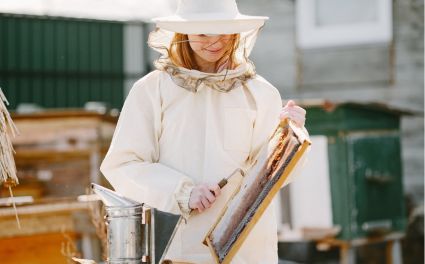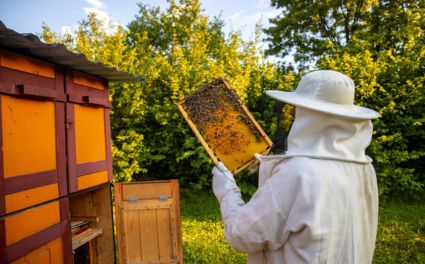Beekeeping is not just harvesting honey, it’s about building a relationship with your humming workforce. A well-lit bee smoker is your key to making sure of peaceful hive inspections, allowing you to work efficiently without alarming your bees. Furthermore, many beekeepers struggle with how to light a bee smoker properly, keep it burning, or control the smoke output.
This blog post will not only walk you through expert tricks but also introduce you to the best fuel options and how to relight a smoker quickly when needed.
And, of course, using the right tools makes a huge difference. Along with high-performance smokers, choosing quality beekeeping suits and beekeeping gloves ensures complete protection during hive inspections.
Let’s jump in!
Why Do Beekeepers Use Smoke? The Logic Behind It
Ever wonder why a few gentle puffs of smoke can modify a defensive colony into a cooperative one? The answer lies in bee communication. When a hive senses danger, worker bees release alarm pheromones to alert their colony. Smoke disrupts this chemical signal, preventing bees from coordinating an aggressive defense.
Additionally, smoke triggers a survival instinct, making bees gorge on honey in case they need to abandon the hive. A full bee is a calm bee, meaning a smoother, sting-free inspection.
Learning how much smoke bees need is key. Too little, and the hive remains on edge. Too much, and the colony becomes disoriented. The right balance makes sure minimal stress for maximum efficiency.
Tip: Wearing a comfortable beekeeping kids suits are essential when young beekeepers join hive inspections, making sure they stay protected and calm.
How To Light A Bee Smoker Like A Pro Humming Friend?
Lighting a bee smoker should be quick, easy, and effective.
Follow these steps to make sure you get a consistent burn:
Start With The Right Fuel:
The key to an efficient smoker is using natural, slow-burning materials. Pine needles, untreated burlap, and wood shavings are the best fuel for a bee smoker because they provide cool, dense smoke without harmful chemicals.
Build A Hot Base:
Crumple newspaper or dry grass and ignite it inside the smoker. Once it’s burning steadily, slowly add larger fuel pieces to extend the burn time.
Layer Your Fuel Correctly:
Avoid packing the smoker too tightly — proper airflow in a bee smoker is essential to maintaining steady smoke output.
Manage Airflow:
Use the bellows to introduce oxygen and keep the embers alive. Our stainless steel beekeeping smoker is made with the best airflow control for effort-free operation.
Pro Tip: Complement your smoker setup with beekeeping veils for extra facial protection during hive inspections.
Check Your Smoke Quality:
White, cool smoke is perfect. Adjust your fuel or airflow for better results if it's too hot or sparse.
Selecting The Best Fuel For A Bee Smoker
Picking the right fuel makes sure long-lasting, cool smoke that won’t irritate your bees.
Here are the top natural fuel options:
-
Pine Needles: Burn slowly and provide a steady smoke output.
-
Burlap (Untreated): Creates a dense, long-lasting smoke.
-
Wood Shavings: Ideal for maintaining embers for extended periods.
-
Herbs (Lavender, Thyme): Not only produce smoke but also add a calming effect for the bees.
For beekeepers seeking sustainable alternatives, bee smoker fuel alternatives like dried corncobs and pelletized fuel work well. Just make sure whatever you use is free from harmful chemicals that could damage your hive.
How To Keep Your Smoker Lit For Longer?
One of the most frustrating experiences is a smoker that keeps going out mid-inspection.
Here’s how to make sure your bee smoker stays lit:
-
Use long-burning fuel like compressed cotton or wood pellets.
-
Maintain airflow by occasionally pumping the bellows.
-
Don’t overfill the chamber — proper spacing between fuel layers keeps embers alive.
-
Use a high-capacity smoker like the OZ Armour stainless steel smoker for extended use without frequent refueling.
Style Tip: If you love standing out in the field, check out our pink beekeeping suit — built for both fashion and functionality!
How To Relight A Smoker Quickly?
If your smoker dies down, don’t start over. Use these quick fixes:
-
Clear excess ash to improve airflow.
-
Add dry kindling like crumpled paper or small twigs.
-
Pump the bellows aggressively to revive the embers.
-
Use our smoker, which retains heat longer, making relighting effortless.
Lighting A Smoker In Windy Conditions
Windy days make it tricky to keep a smoker lit. Follow these expert tips to overcome the challenge:
-
Light your smoker in a wind-sheltered area before heading to the hive.
-
Use heavier fuels like wood pellets that burn slower and steadier.
-
Keep the smoker angled away from the wind to prevent the flames from extinguishing.
-
Invest in a wind-resistant smoker like the heavy-duty smoker, for stability in tough conditions.
How Much Smoke Do Bees Need?
Too much smoke overwhelms the colony, while too little leaves them defensive.
Here’s the ideal approach:
-
Entrance Puff: A couple of puffs at the hive entrance signal your arrival.
-
Between Frames: Light puffs between frames keep the bees calm without suffocating them.
-
Avoid Over-Smoking: Excessive smoke can agitate the bees, defeating the purpose.
Make The Bee Smoker Your Ally!
Beekeeping should be a stress-free and enjoyable experience, and a properly used bee smoker is a beekeeper’s best friend. By picking up the right fuel, maintaining airflow, and using high-quality tools like our professional beekeeping smokers, you can manage hive inspections with ease.
So, the next time you suit up, remember: a well-lit smoker is the key to a peaceful hive and a happy beekeeper. Light it right, use the best materials, and make your beekeeping experience smoother than ever!



